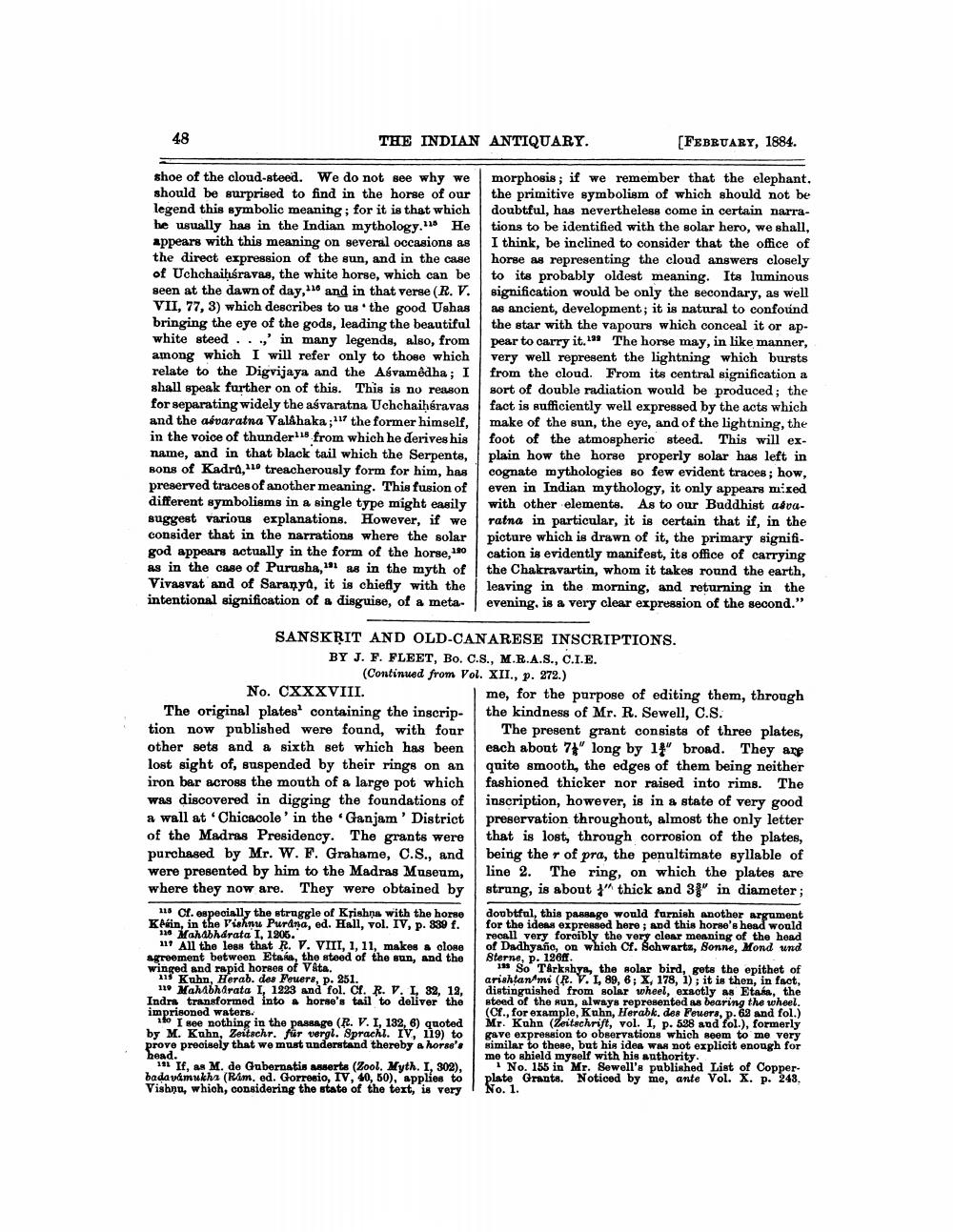________________
48
THE INDIAN ANTIQUARY.
[FEBRUARY, 1884.
shoe of the cloud-steed. We do not see why we should be surprised to find in the horse of our legend this symbolic meaning; for it is that which he usually has in the Indian mythology. 11 He appears with this meaning on several occasions as the direct expression of the sun, and in the case of Uchchaihấravas, the white horse, which can be seen at the dawn of day, and in that verse (R. V.
II, 77, 3) which describes to us the good Ushas bringing the eye of the gods, leading the beautiful white steed...' in many legends, also, from among which I will refer only to those which relate to the Digvijaya and the Asvamëdha; I shall speak further on of this. This is no reason for separating widely the aśvaratna Uchchaihấravas and the abvaratna Valahaka;117 the former himself, in the voice of thunder 15 from which he derives his name, and in that black tail which the Serpents, Bons of Kadra, treacherously form for him, has preserved traces of another meaning. This fusion of
fferent symbolisms in a single type might easily suggest various explanations. However, if we consider that in the narrations where the solar god appears actually in the form of the horse, 180 as in the case of Purusha, as in the myth of Vivasvat and of Saranya, it is chiefly with the intentional signification of a disguise, of a meta-
morphosis; if we remember that the elephant, the primitive symbolism of which should not be doubtful, has nevertheless come in certain narrations to be identified with the solar hero, we shall, I think, be inclined to consider that the office of horse as representing the cloud answers closely to its probably oldest meaning. Its luminous signification would be only the secondary, as well as ancient, development, it is natural to confound the star with the vapours which conceal it or appear to carry it. The horse may, in like manner, very well represent the lightning which bursts from the cloud. From its central signification a sort of double radiation would be produced; the fact is sufficiently well expressed by the acts which make of the sun, the eye, and of the lightning, the foot of the atmospheric steed. This will explain how the horse properly solar has left in cognate mythologies so few evident traces; how, even in Indian mythology, it only appears mixed with other elements. As to our Buddhist advaratna in particular, it is certain that if, in the picture which is drawn of it, the primary signifi. cation is evidently manifest, its office of carrying the Chakravartin, whom it takes round the earth, leaving in the morning, and returning in the evening, is a very clear expression of the second."
SANSKRIT AND OLD-CANARESE INSCRIPTIONS.
BY J. F. FLEET, Bo. C.S., M.R.A.S., C.I.E.
(Continued from Vol. XII., p. 272.) No. CXXXVIII.
me, for the purpose of editing them, through The original plates' containing the inscrip- the kindness of Mr. R. Sewell, C.S. tion now published were found, with four The present grant consists of three plates, other sets and a sixth set which has been each about 7" long by 14" broad. They are lost sight of, suspended by their rings on an quite smooth, the edges of them being neither iron bar across the mouth of a large pot which fashioned thicker nor raised into rims. The was discovered in digging the foundations of inscription, however, is in a state of very good a wall at Chicacole' in the Ganjam District preservation throughout, almost the only letter of the Madras Presidency. The grants were that is lost, through corrosion of the plates, purchased by Mr. W. F. Grahame, C.S., and being the r of pra, the penultimate syllable of were presented by him to the Madras Museum, line 2. The ring, on which the plates are where they now are. They were obtained by strung, is about f" thick and 3" in diameter;
115 Cf. especially the struggle of Krishna with the horse doubtful, this passage would furnish another argument Kein, in the Vishnu Purana, ed. Hall, vol. IV, p. 839 f. for the ideas expressed here ; and this horse's head would 136 Mahabharata I, 1906.
recall very forcibly the very clear meaning of the head ut All the less that R. V. VIII, 1, 11, makes a close of Dadhyaño, on which Cf. Schwartz, Sonne, Mond und agreement between Etas, the steed of the sun, and the Sterne, p. 126ff. winged and rapid horses of Vata.
11 So Tárkshy, the solar bird, gots the epithet of 1 Kuhn, Herab. des Mouere, p. 251.
arishtan mi (R. V. I, 89, 6; X, 178, 1): it is then, in fact, 11. Mahabharata I, 1223 and fol. Cr. R. V. I, 82, 12, distinguished from solar wheel, exactly as Etnia, the Indrs transformed into a horne's tail to deliver the steed of the sun, always represented as bearing the wheel. imprisoned waters.
(cf., for example, Kuhn, Herabk. des Feuers, p. 62 and fol.) 1fo I see nothing in the passage (R. V. I, 132, 6) quoted Mr. Kuhn (Zeitschrift, vol. I, p. 588 and fol.), formerly by M. Kuhn, Zeitschr. fir vergl. Sprachl. IV, 119) to gave expression to observations which seem to me very prove precisely that we must understand thereby a horse'. similar to these, but his idea was not explicit enough for
me to shield myself with his anthority. 111 If, as M. de Gubernatis asserts (Zool. Myth. I, 302), No. 155 in Mr. Sewell's published List of Copper bada vámukha (Ram. ed. Gorrosio, IV, 40, 50), applies to plate Grants. Noticed by me, ante Vol. X. p. 243, Vishnu, which, considering the state of the text, is very No. 1.
heade precisely Zertochromesango (R.




